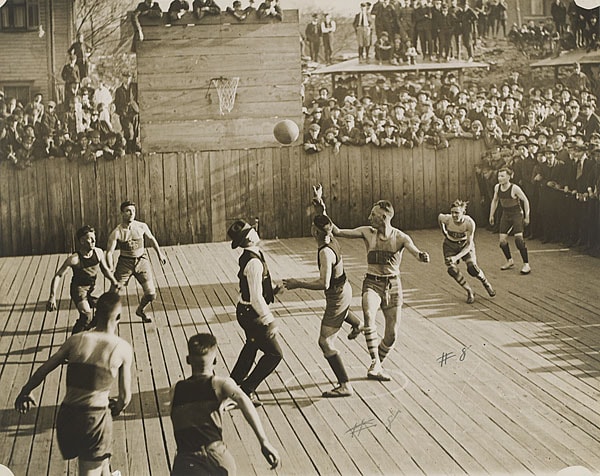
Game between Boy’s High School and Tech High School ca.1921
With our billion-dollar sports arenas, museums, and restaurants, Atlanta is an ideal city for hosting professional and collegiate sporting events—especially basketball. Since 1971, Atlanta has made history by hosting the NCAA’s Division I Men’s and Women’s Basketball Tournament over two dozen times, including three men’s and two women’s Final Four championships.
You might think that Atlanta’s basketball legacy started in the 1960s, when the St. Louis Hawks relocated to Alexander Coliseum on Georgia Tech’s campus. However, our roots grow much deeper than that.
Early Days in the A
Far from Atlanta’s hustle and bustle, in the cold winter months of 1891, Dr. James Naismith was on a mission. Naismith, a newly minted teacher at the YMCA. Training School in Springfield, Massachusetts, was tasked by the school’s athletic director to create a new game for his students to play indoors away from the elements, one that wasn’t as rough as the brutal game of football. Naismith took a soccer ball that players could pass back and forth and lob into peach baskets nailed into either end of the gymnasium ten feet off the ground. His new game of “Basket Ball” quickly caught on at YMCAs, high schools, and colleges across the country.
On March 24, 1893, the YMCA at the corner of Pryor and Wheat Street (later named Auburn Avenue) held a basketball demonstration, introducing the game to Atlanta. The local YMCA was the focal point of the game until Atlanta’s prep schools organized a league in the early 1900s to formalize competition.
A player from Boy’s High shoots a free throw in a way only someone from the 1920s would
In the 1920s, the Atlanta Athletic Club sponsored an excellent team that featured some of the best college and amateur players in the state. The Club played colleges in the Southeast as well other athletic clubs in Georgia, North Carolina, and as far away as Kansas City, Missouri until the team disbanded in 1932.
At the collegiate level, Georgia Tech has fielded a basketball team since 1906, and has seen great success with its program, especially in the 1980s and 1990s as coach Bobby Cremins led the school to nine straight NCAA Men’s Basketball Tournament appearances, including a Final Four appearance in 1990. Georgia State University has been to the NCAA Tournament five times, while the Mercer Bears have appeared three times, most recently in 2014 when they upset third-seed Duke University 78-71 before losing to Tennessee.
Pistol Pete Maravich makes a shot during his premier season with the Hawks in 1970. A highly sought-after draft pick, Maravich is the all-time leading NCAA Division I scorer with 3,667 points scored and an average of 44.2 points per game.
Building Up
In the 1960s, Atlanta’s political and business leaders were determined to make ours the next great metropolitan city and surpass its provincial image. To make that happen, they needed the presence of professional sports teams.
In 1968, real estate mogul Thomas Cousins bought the St. Louis Hawks and moved the team south, despite the lack of a professional basketball facility. The Atlanta Hawks played at the Alexander Coliseum at nearby Georgia Tech for four seasons before plans for a new sports arena were realized in October 1972 with the opening of the Omni Coliseum.
The Omni was a $17 million indoor arena built over an unused railroad gulch in the downtown area. Its name comes from the Latin omnis meaning “all” and reflected its purpose to accommodate a thorough variety of sporting and entertainment events.
Construction on the 16,500-seat facility began in April 1971 and was completed in time for the first professional hockey game of the season when the expansion Atlanta Flames – also owned by Cousins – played against the Buffalo Sabres in October 1972. The following night, the Atlanta Hawks played the New York Knicks.
With the earlier additions of the Braves and Falcons in 1966 who played at the 60,000-seat capacity Atlanta Stadium, Atlanta was now a big-league city with four professional teams and the professional facilities needed to accommodate each.
In 1997, the Omni was levelled to make way for Phillips Arena, a more expansive, sleek structure with a greater capacity for luxury suites—and greater potential for generating revenue.
Atlanta’s women’s basketball team from 1902. Rarely do we have the name of everyone on a group shot. These history-making women are, left to right, beginning on the front row: Julia Porter, May DuBignon, Josie Stockdell, Florence Jackson, Nan DuBignon, Louise Black, Mary Ann Phelan, Estelle Stewart, Sarah Calhoun, Louis Gay, Daisy Stewart, Anita Black, Ada Alexander, and Gordelia Gray.
Women on the court
In its early years, basketball was played by both men and women. In 1902, a group of twenty “society women” in Atlanta formed a club to play on an empty lot at the corner of Peachtree and Fourteenth Street, near today’s Colony Square.
“The sport encourages a strong, straight carriage and grace of movement.” In order to maintain a “ladylike” appearance, early women’s games were played with amended rules. Team sizes increased to nine players per side, and each player was assigned to one of three segments of the court. The guards, centers, and forwards had to remain in their designated section and could not run across the court in order to avoid “nervous fatigue” caused by strenuous activity.
“Basket ball is incontestably the best athletic game for school girls in the south.”
Fast forward nearly 100 years to the Centennial Olympic Games. Held in Atlanta in 1996, the Games brought international attention to both Atlanta and to women’s basketball. Kicking off the first of eight consecutive gold medal wins, the US Women’s National Team swept the court to reclaim the title lost in Barcelona in ‘92. Ours remains the winningest nation in both Women’s and Men’s Basketball at the Olympic Games. Even before their 1996 victory, there had been discussions to establish an American Basketball League team in Atlanta. On the heels of the US Women’s National Basketball Team’s gold medal, the WNBA launched its inaugural season in 1997. In 1996, the Atlanta Glory launched at Atlanta’s first women’s basketball team. When the American Basketball Association folded in 1998, so did the Glory. It would take another decade before the WNBA seeded a team in Atlanta. Today, the Atlanta Dream has won three conference finals and sent two players to the Olympics—Angel McCoughtry and Érika de Souza.
He’s the Human Highlight Reel. Jacques Dominique Wilkins played for the Atlanta Hawks from 1982–1994. Wilkins was a nine-time NBA All-Star, and is widely viewed as one of the best dunkers in NBA history.
Bro, or no?
The Atlanta Hawks have historically been good enough to advance to post-season play in more recent years but have advanced to the Eastern Conference Finals only twice since 1970. Its all-time roster of players includes guard Pete Maravich, center Dikembe Mutombo, and forward Dominique Wilkins.
While their record may not be spotless, their fanbase, known as Hawksbros, are voracious. Atlanta, a city of distinct neighborhoods and communities, often finds itself coming together in unexpected ways. Sports give us an excuse to come together as individuals to cheer on a common team. The Hawks and the Dream are both integral to our city’s history and its future as an enterprising city in the South.


